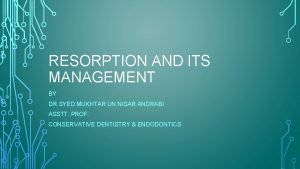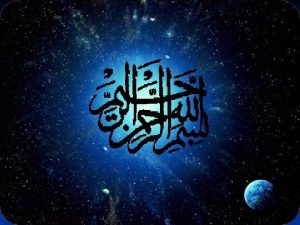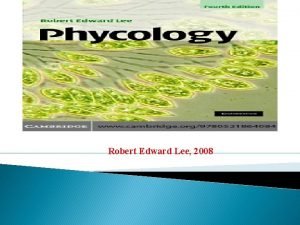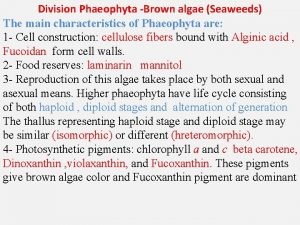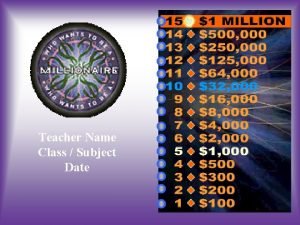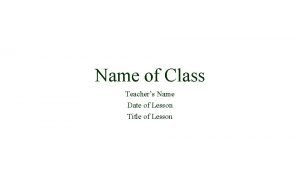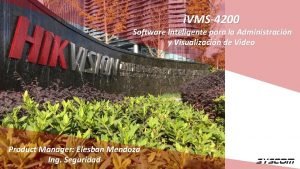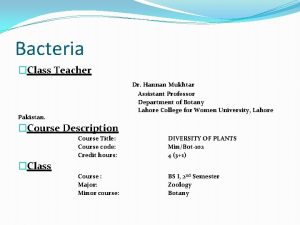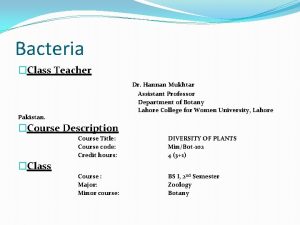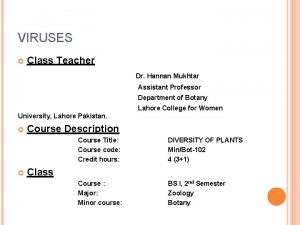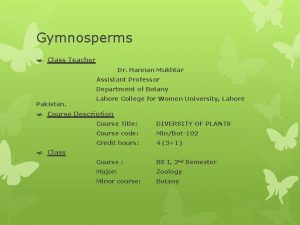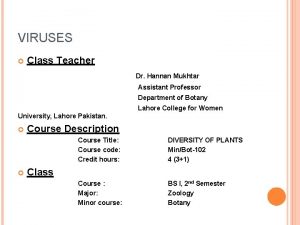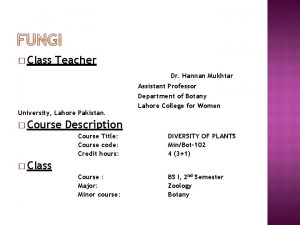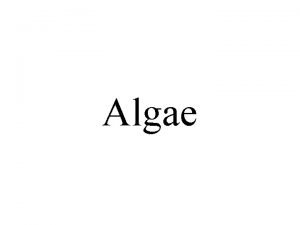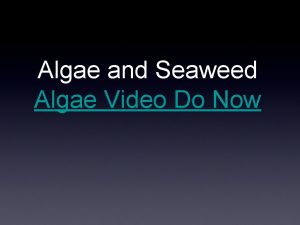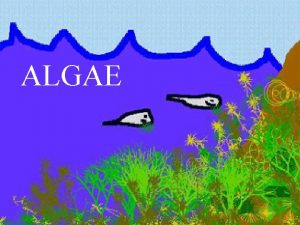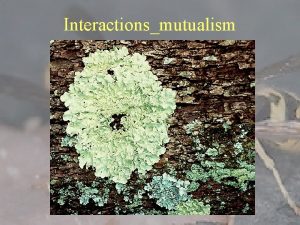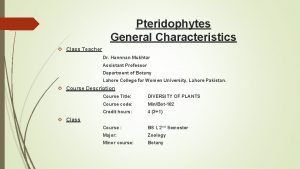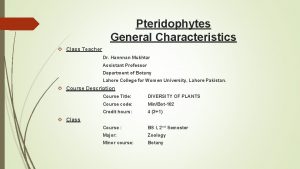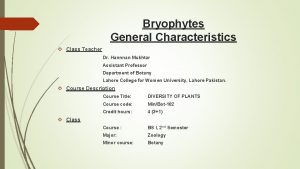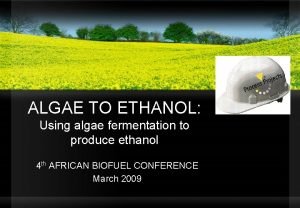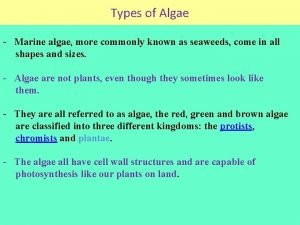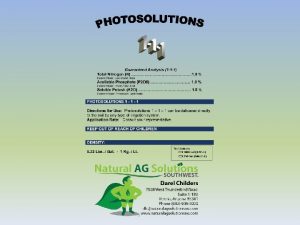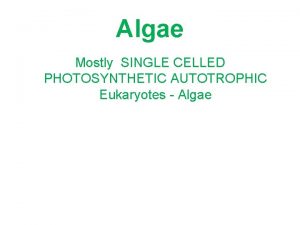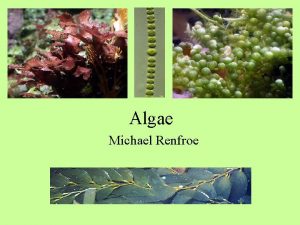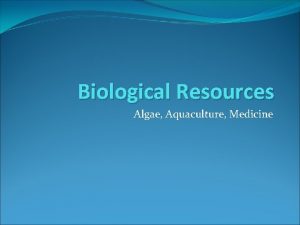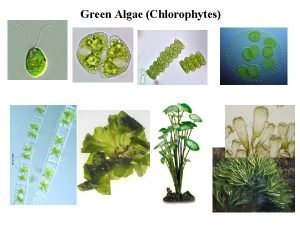ALGAE Class Teacher Dr Hannan Mukhtar Assistant Professor
































- Slides: 32

ALGAE �Class Teacher Dr. Hannan Mukhtar Assistant Professor Department of Botany Lahore College for Women University, Lahore Pakistan. �Course Description Course Title: Course code: Credit hours: DIVERSITY OF PLANTS Min/Bot-102 4 (3+1) Course : Major: Minor course: BS I, 2 nd Semester Zoology Botany �Class

Algae �General characters of Algae �https: //www. easybiologyclass. com/alg ae general characters ppt/

Cyanophyta Prokaryote also called blue green algae � Mostly present in aquatic habitat � Single celled/ colonial/ Filamentous � Vegetative cells are photosynthetic � Specialized cella – Hetrocysts (barell shaped cells), contain enzyme nitrogenase for nitrogenfixation. � Has the pigment chlorophyll, the pigment phycobilin carotenoid and consisting of phycocyanin (blue), and phycoerithrin (red). These pigments create a bluish green color. � 4. Chlorophyll is not contained within the chloroplasts, but scattered throughout the protoplasm. � The body structure is simple, the cell walls contain pectin, hemicellulose and cellulose are sometimes in the form of mucus. �

�In the middle of the cell there is a section which is colorless containing DNA and RNA. � There is a reserve of glycogen as a food substance and there beside the granules. �Green algae blue shaped filaments can also form a thick walled spores that are resistant to hot and dry and can bind N (nitrogen) is heterocyst. �

Habitat �Cyanophyta members are generally found in freshwater and humid places. In addition to that they live in hot water with temperatures reaching 85 ° C. �Some species can live in polluted water and can be used as an indicator of organic pollution.

Cell Structure �Cyanobacteria body constituent cell structure similar to Gram negative bacterial cell, cell wall containing peptidoglycan layer thin. �Cyanobacteria cell consists of parts, namely the mucus layer, the cell wall, plasma membrane, photosynthetic membranes, mesosom, cytoplasm, ribosomes, granule storage, gas vacuole, protein dense, and nucleoplasm (DNA). �

�A layer of mucus, blanketing the cell wall. Mucus helps in sliding motion in unicellular cyanobacteria, as well as vibrate back and forth motion (oscillation) For example Oscillatoria sp. � The cell wall, contains a thin peptidoglycan layer and serves to provide a fixed form in algae and protects the cell contents. � The cell membrane (plasma membrane), is selectively permeable and serves wraps cytoplasm and regulates the exchange of substances.

� Mesosom, a membrane protrusion into the cytoplasm and serves to produce energy. � Cytoplasm, a colloidal solution composed of water, protein, fat, sugar, minerals, and enzymes. In the cytoplasm are ribosomes , granule storage, gas vacuole, protein dense, and nucleoplasm (DNA). � The ribosome, a tiny organelles that function for protein synthesis. � Gas vacuoles, filled with air that causes the body Cyanobacteria can float on the water surface, so it gets sunlight for photosynthesis. � Nucleoid, is the genetic material that is composed of DNA and are not surrounded by a membrane. Nucleoid contained in a specific location. � Photosynthetic membrane (thylakoid membrane), the folding of the plasma membrane toward the cytoplasm that serve to photosynthesize. Photosynthetic membranes containing chlorophyll (green), carotene, and other photosynthetic pigments, among others fikoeritrin (red) and phycocyanin (blue). The combination of these pigments cause Cyanobacteria different colors, such as yellow, red, brown, violet, bright green, bluish green, even black.

Reproduction �Asexual reproduction, by fragmentation and akinete formation.

�Economic importance �Nitrogenfixation �http: //domainbiology. blogspot. com/20 17/10/cyanophyta characteristics. html.

NOSTOC

� Thalli are present in the form of colony. � Ball like colony is enveloped by a gelatinous sheath � Balls are greenish to bluish green in colour. � 4. Each colony contains thousands of straight or twisted filaments or trichomes (Fig. 57). � 5. Each trichome is surrounded by its individual sheath and is called the filament. � 6. A trichome is contorted and consists of many cells arranged in a beaded manner (Fig. 58). NOSTOC

�. Each cell is somewhat cylindrical or spherical in shape. � 8. In filaments there are present some large, spherical or cylindrical, colourless empty cells called hetero cysts. � 9. Heterocysts are generally intercalary but in the young condition, they may be terminal. � 10. Two polar nodules are present in each heterocvst

� Some cells of the filament become enlarged and filled with the food material. These thick walled cells are called akinetes. Akinetes are generally present in chain. � ADVERTISEMENTS: � A Single Cell: � 1. Each cell is surrounded by a cellulose cell wall (Fig. 59 A). � 2. Protoplast shows the typical Myxophycean structure, i. e. , inner colourless centroplasm and outer pigmented chromoplasm. In the chromoplasm are present pigments, proteinaceous cyanophycin granules and cyanophycin starch granules while in the centroplasm is present the incipient nucleus.

LINKS/URLS �https: //www. google. com/search? q=nosto c+diagram&sxsrf=ALe. Kk 03 JSA 6 DD 23 P w. Bd. Bqu. Hg. Qi. UY_C 130 A: 158890088980 2&tbm=isch&source=iu&ictx=1&fir=y 50 K 5 PIY_Tn. PWM%253 A%252 Cmz 1 h. UYzk 5 GOT 6 M%252 C_&vet=1&usg=AI 4_ k. TJT 6 vlo 5 Izse. PFBq. Ti. Ay. L 9 z. Px. VWQ&sa =X&ved=2 ah. UKEwjztvq. Ija. Pp. Ah. WNz. IUK HXv. ZBk 0 Q 9 QEw. AXo. ECAg. QKQ&biw=1 366&bih=657#imgrc=Cqx_MJrrb. FGCJM

chlorophyta �General chracters �https: //www. youtube. com/watch? v=h. K b. ZVZ 7 WPFk

Vol. Vox �https: //istudy. pk/volvox/

Charophyta �https: //biologyboom. com/division charophyta/

Chara �http: //www. biologydiscussion. com/alg ae/chara occurrence features and reproduction/46890

Phaeophyta �General chracteristics It is a large group of algae consisting of 240 genera and over 1, 500 species. They are commonly known as brown algae, due to the presence of a golden brown xanthophyll pigment, fucoxanthin (C 40 H 54 O 6) in the chromatophores. � About 99. 7% members are marine and a few grow in fresh water � Plant body is immobile, multicellular and highly differentiated both externally and internally. [Unicellular, colonial (motile and non motile) and unbranched filamentous forms are completely absent. �

� They range from simple microscopic heterotrichous filament (Ectocarpus) to largest alga (Macrocystis pyrifera), which attains a length of 60 90 meters. (The largest forms are known as kelps or rockweeds. Lessonia davicans reachs a length of 4 meters and looks like a miniature tree. Nereocystis luelkeana, the bladder kelp which attains a length of 25 30 meters. Postelsia palmae formis appears like a palm tree and com monly known as Sea Palm) (Fig. 3. 109). �


� Commonly the plant body is differentiated into hold fast, a short or elongated stipe and an expanded blade. The blade performs photosynthesis and bears reproductive struc tures. Many species remain afloat by having air bladders � . The photosynthetic pigments include chlorophyll a, chlorophyll c, β-carotene and xanthophylls like lutein, fucoxanthin, flavoxanthin and violaxanthin. The fucoxan thinis however present sufficiently which partially mask the chlorophyll and carotenoid, thereby giving the characteristic brown colouration

� The growth of the plant body may be apical (Fucales, Dictyotales), intercalary (Laminariales) or trichothallic (Ectocarpales). � 6. The cell wall is differentiated into outer and inner layers. The outer mucilaginous layer has fucinic and alginic acid, but the inner layer is mainly cellulosic. [The alginic acid is used to manufacture artificial silk and adhe sive, obtained commercially from Sargassum, Laminaria etc].

� The cells usually have many small vesicles and white granules. The granules are called fucosan vesicles. Pyrenoides are usually absent, but, if pre sent, is of single stalk type. � Motile structures (zoospores and gametes) have two laterally inserted unequal flagella, of which larger one is tinsel or pantonema tic and the smaller one is whiplash or acronematic type. � The reserve foods are commonly laminarin and mannitol. Sucrose and glycerol are also present in some members. � They reproduce by all the three means: vegetative, asexual and sexual. �

� Vegetative reproduction takes place by fragmentation. Special reproductive bran ches, the propagules, are developed in some members of Sphacelariales; those develop to new plants after detachment. � b. Asexual reproduction takes place by zoospores except Tilopteridales, Dictyotales and Fucales. The zoospores produced in unilocular sporangia are haploid, while in pleurilocular sporan gia they are diploid. � c. Sexual reproduction ranges from isogamy (Ectocarpales and Sphacela riales) to oogamy (Fucales, Dictyotales and Laminariales) through anisogamy (Cutleriales and Tilopteridales).

The members show various types of alternation of generations i. e. , isomorphic (Ectocarpus), heteromorphic (Laminaria) or diplontic (Sargassum). � The members of Phaeophyceae show two types of life cycle: � 1. Diplontic life cycle e. g. , Sargassum. � 2. Diplohaplontic life cycle. � ADVERTISEMENTS: � It is of two types: � i. Isomorphic type e. g. , Ectocarpus. � ii. Heteromorphic type e. g. , Laminaria. � http: //www. biologydiscussion. com/algae/phaeophyceae brown algae description and classification/46948 �

Ectocarpous �Follow link http: //www. biologydiscussion. com/alg ae/ectocarpus occurrence features and reproduction/46968

Rodophyta � Characteristics: The red colour of these algae results from the pigments phycoerythrin and phycocyanin; this masks the other pigments, Chlorophyll a (no Chlorophyll b), beta carotene and a number of unique xanthophylls. The main reserves are typically floridean starch, and floridoside; true starch like that of higher plants and green algae is absent. The walls are made of cellulose and agars and carrageenans, both long chained polysaccharide in widespread commercial use. There are some unicellular representatives of diverse origin; more complex thalli are built up of filaments.

A very important group of red algae is the coralline algae, which secrete calcium carbonate onto the surface of their cells. Some of these corallines are articulated (right, Corallina, with flexible erect branches; others are crustose (below). These corallines have been used in bone replacement therapies. Coralline algae were used in ancient times as vermifuges, thus the binomial Corallina officinalis. � Several red algae are eaten: best known amongst these is dulse (Palmaria palmata above) and Carrageen Moss (Chondrus crispus and Mastocarpus stellatus). � � The red algae Kappaphycus and Betaphycus are now the most important sources of carrageenan, a commonly used ingredient in food, particuarly yoghurts, chocolate milk and repared puddings. Gracilaria, Gelidium, Pterocladia and other red algae are used in the manufacture of the all important agar, used widely as a growth medium for microorganisms, and for food and biotechnological applications.

�http: //www. seaweed. ie/algae/rhodoph yta. php

Batrachospermum �http: //www. yourarticlelibrary. com/repro duction/batrachospermaceae the occurrence structure and reproduction of family/7480
 Hannan e freeman
Hannan e freeman Syed mukhtar ahmed
Syed mukhtar ahmed Sudden painless loss of vision
Sudden painless loss of vision Promotion from assistant to associate professor
Promotion from assistant to associate professor Cuhk salary scale 2020
Cuhk salary scale 2020 Anwser
Anwser Lee classification of algae 2008
Lee classification of algae 2008 Cryptostomate
Cryptostomate S+tobe+ving
S+tobe+ving Deped erf requirements
Deped erf requirements Teacher
Teacher Name class subject school
Name class subject school Probability of a given b venn diagram
Probability of a given b venn diagram Name teachers name class date
Name teachers name class date Good morning class images
Good morning class images Name date class teacher
Name date class teacher Obedience to teachers
Obedience to teachers Good evening student
Good evening student The direct method advantages and disadvantages
The direct method advantages and disadvantages Name class teacher date
Name class teacher date Name class teacher date
Name class teacher date The sign makers assistant
The sign makers assistant Workkeys applied mathematics level 4 answers
Workkeys applied mathematics level 4 answers The adaa was formed in 1924 by:
The adaa was formed in 1924 by: Home assistant fglair
Home assistant fglair Medical assistant rop
Medical assistant rop Mia irwan
Mia irwan Cisco configuration assistant 3.2 download
Cisco configuration assistant 3.2 download Kpu health care assistant
Kpu health care assistant Reardon commerce
Reardon commerce Interview questions for student assistant
Interview questions for student assistant Ibm support assistant workbench
Ibm support assistant workbench Hikvision recording assistant
Hikvision recording assistant

